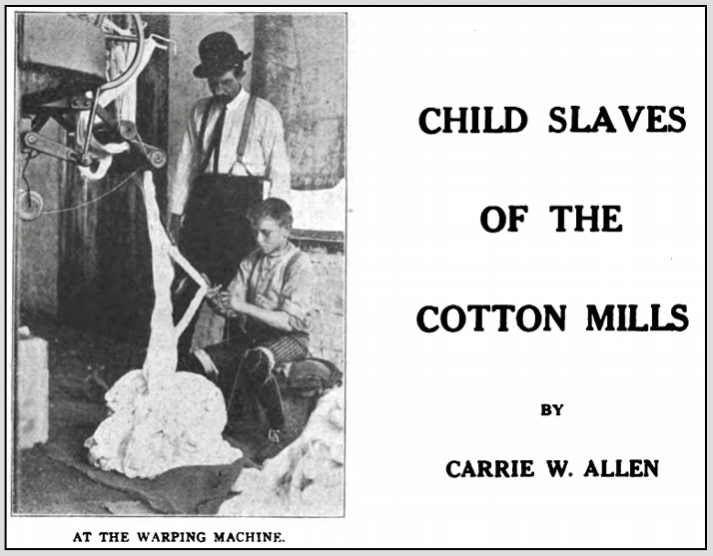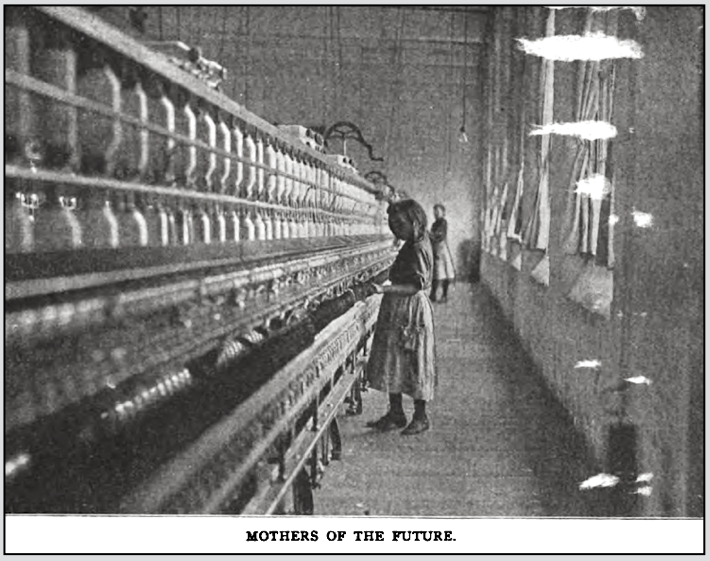
Hellraisers Journal – Saturday March 4, 1911
Carrie W. Allen on Child Slaves of the Cotton Mills, Part I
From the International Socialist Review of March 1911:
[Part I of II.]
THE shrill scream of the factory whistle smites the chill morning air at the dawn of each new day, and obedient to its hideous call, a ghostly array of anemic children, rudely awakened from sleep, gulp down a bit of food and stumble sleepily to the factory door.
This pitiful multitude of children, whose days are completely swallowed by the cotton mills, keep up their incessant dance from one spindle to another, or from one loom to another, dizzily watching the ten, twelve or fifteen shuttles play hide and seek among the labyrinth of threads.
So much has been written about these youngest victims of capitalist greed, the children of the cotton mills, that were we not misery hardened, were we not blinded by brutal toil, long ago an awakened working class would have united to wipe this iniquity out.
And yet, the workers are not to blame that the forced struggle for existence has limited their vision and stupefied their imagination.
One little child set in the midst of a crowd, because in his person misery is visualized, makes a more eloquent appeal than the story of all the thousands of children whose lives are crushed by the cruel millstones of industry.
While the laws of most of the northern states place the legal working age of a child at fourteen, the last Senate report on Women and Children Wage Earners in the Cotton Industry shows that 34.8 per cent of the factories investigated in New England employed children under the legal age.
In at least four of the New England states, tiny children, frail and undeveloped, are on the pay-rolls of the cotton mills, some of them apparently not more than eight years of age.
An effort is always made to shift the responsibility of these little ones from the shoulders of the employer of their labor to the parents of the children. “We cannot help it if the parents tell us the children are older than they are,” say the manufacturers. “We are in business, first of all, to make money.”
That is the key to the situation. The manufacturers are in business to make money. As the children are cheap, and more profit may be squeezed out of their labor, they are claimed by the mill.
Many people excuse the indifference of the manufacturer on the ground that many of the children are foreigners, as though it were less a crime to injure a child of foreign parents than one of native blood. A child is a child, regardless of color or race.
In the Southern cotton mills, where more terrible wrongs are perpetrated against the children than in any other part of the country, this excuse cannot be offered, for the children are, without exception, American. The people of the mill villages are the purest American blood that we have, many families having come from the mountains of Tennessee and the Carolinas.
From time to time, smooth-tongued agents are sent into these regions to scatter cleverly worded dodgers about, and to visit the hill people in their homes, for the purpose of finding fresh material as grist for the remorseless mill.
Frequently the agent finds a large family living in a wretched shack of one or two rooms, dragging out a meager existence on a worn-out patch of ground, scarcely knowing the color of a dollar, and with no advantages of any sort for their children.
It is not a difficult matter to convince the father of the advantages to be gained by a move to the mill village. The family have nothing to lose and everything to gain. It will cost them nothing, for the money will be advanced to move them all. Work will be given to all of the family, and even the little ones will be able to earn from fifty cents to a dollar a day.
Or, if the children wish to go to school, and this appeals most strongly to the mother, the children will have a chance for a good education, and all the other advantages her bare life has so cruelly lacked.
A chance of an education for her girls. A chance in life for her boys. In addition to this, the dollar-earning capacity of the group during the months of vacation makes an eloquent appeal to the parents, who have only known privation throughout their barren lives. The tickets are sent, and the family, with hearts full of expectant hope, move as soon as possible to the hideous mill town.
When the father enters the mill he is obliged to make affidavit as to the ages of his children, and they are greedily watched, the mill owner regarding them as perfectly legitimate grist for his mill. Apropos of the claim that the mill owners are not to blame, the government investigators into the conditions of the children in the cotton mills make some very incriminating statements.
When the children are not forthcoming, the mill superintendents frequently go into the homes of the mill workers, demanding that children of nine and ten be sent into the mill, threatening the father with discharge and the family with eviction in case the children are withheld.
“They just keep at a person until they have to let them work, whether they want to or not. I don’t want them to know I’ve got another gal, or they’d have her right in that mill,” said a South Carolina woman, speaking of her little girl of nine.
A mother in North Carolina pleaded with the mill superintendent not to compel her to take her two boys, eleven and fourteen, from school, but decided to do as she was told when her husband was threatened with the loss of a job.
When the government investigator went to the mills, as happens with all inspectors, an alarm was given, and the children sent home or hidden in waste boxes or closets. In one of the North Carolina mills the superintendent was boasting, “We haven’t got a lot of babies in our mills,” when his attention was called to a tiny girl of six who was trying to reach the frames.
The very little ones are not usually on the pay-rolls of the mills, the pittance earned by the little one going into the pay envelope of the mother or an older child. In some of the mills, children were found of not more than ten years of age, who were compelled to work an additional number of hours during the day, after working twelve weary hours during the night, one particular child of ten kept steadily at her task on several occasions for a stretch of twenty-four hours.
[Emphasis added.]
———-
~~~~~~~~~~~~~~~~~~~~~~
SOURCES & IMAGES
Mother Jones Quote, Child Labor Man of Six Snuff Sniffer
https://www.iww.org/history/library/MotherJones/autobiography/14
The International Socialist Review, Volume 11
(Chicago, Illinois)
-July 1910 to June 1911
Charles H. Kerr & Company, 1911
https://www.marxists.org/history/usa/pubs/isr/
https://books.google.com/books?id=8-05AQAAMAAJ
ISR – Mar 1911
https://www.marxists.org/history/usa/pubs/isr/v11n09-mar-1911-ISR-gog-Corn-OCR.pdf
See also
-re Carrie W. Allen, see:
Passaic (NJ) Daily News of Feb 6, 1911
https://www.newspapers.com/image/556222486/
Almost every seat in the Hippodrome Theater, in Main Avenue, was occupied yesterday afternoon at the lecture entitled “Woman and the Social Revolution,” delivered by Mrs. Carrie W. Allen, the noted New York lecturer and journalist, under the auspices of the Passaic Socialist Forum.
Dec 1908
Boy at warping machine, Catawba Cotton Mill, Newton, N.C. Location: Newton, North Carolina.
-by Lewis Hine
https://www.loc.gov/pictures/item/2018674970/
Nov 1908
Sadie Pfeifer, 48 inches high, has worked half a year. One of the many small children at work in Lancaster Cotton Mills. Nov. 30, 1908. Location: Lancaster, South Carolina.
-by Lewis Hine
https://www.loc.gov/pictures/item/2018674894/
Lewis Hine
https://en.wikipedia.org/wiki/Lewis_Hine
National Child Labor Committee Collection
https://www.loc.gov/pictures/collection/nclc/background.html
Senate Report on Condition of Woman and Child Wage-Earners in the United States in 19 Volumes
Volume I: Cotton Textile Industry
WDC, 1910
https://babel.hathitrust.org/cgi/pt?id=osu.32435026689562&view=image&seq=7
~~~~~~~~~~~~~~~~~~~~~~~~~~~~~~~~~~~~~
Babies in the Mills – Dorsey Dixon


